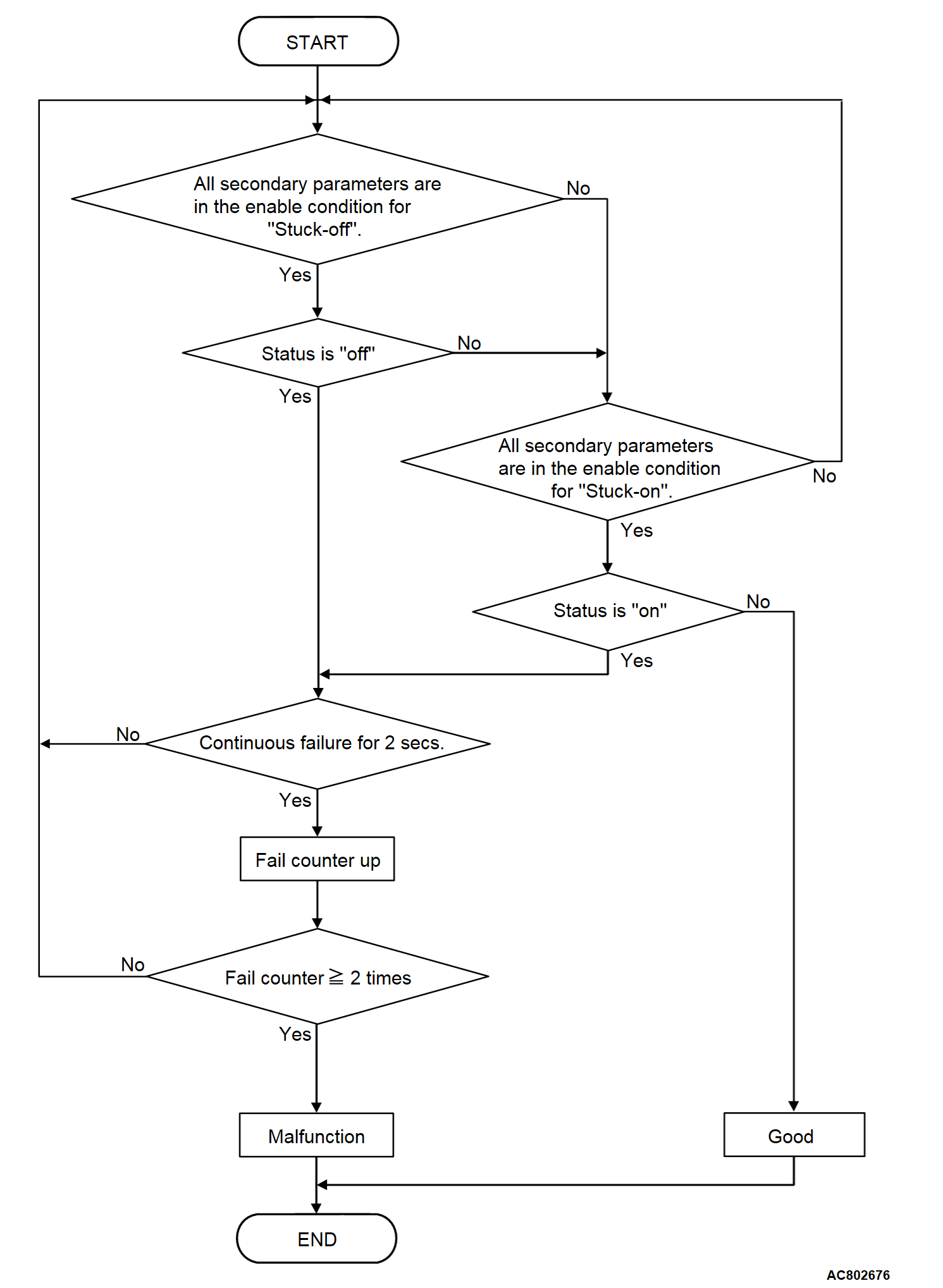DTC P0876: High Clutch Pressure Switch System
DESCRIPTIONS OF MONITOR METHODS
With the solenoid failure not detected and with 4th to 6th gear driving, the switch OFF status continues for 2 seconds. (The detection is achieved twice during 1 driving cycle*1, and it continues for 2 driving cycles.)
*1: Indicates the series of driving cycle "ignition key OFF → ON → drive → OFF." The "1 driving cycle," "2 driving cycle," and so on indicates how many cycles are required to detect a failure.
MONITOR EXECUTION
- Transmission range switch position: R, D, L
- Engine speed: 305 r/min or more
- A/T fluid temperature: -40°C (-40°F) or more
MONITOR EXECUTION CONDITIONS (OTHER MONITOR AND SENSOR)
Other Monitor (There is no temporary DTC stored in memory for the item monitored below)
- Not applicable
Sensor (The sensor below is determined to be normal)
- Not applicable
DTC SET CONDITIONS
Check Conditions <Stuck-off>
- Transmission range switch position: D
- Gear position: 4th, 5th, 6th
- Time after shift changing finish: 2 seconds or more
Judgment Criteria <Stuck-off>
- High clutch pressure switch status: OFF (2 seconds × 2 times)
Check Conditions <Stuck-on>
- Transmission range switch position: D or R
- Gear position: 1st, 2nd, 3rd, reverse
- Time after shift changing finish: 2 seconds or more
Judgment Criteria <Stuck-on>
- High clutch pressure switch status: ON (2 seconds × 2 times)
OBD-II DRIVE CYCLE PATTERN
Drive in 4th, 5th, and 6th gears for 2 seconds or more.
PROBABLE CAUSES
- Malfunction of the high clutch pressure switch system circuit
- Damaged harness or connector
- Malfunction of the TCM
- Malfunction of the high clutch pressure switch system (valve body assembly)
- Malfunction of the valve body assembly, abnormal hydraulic circuit valve.
| caution | For the incomplete gear shifting and slippage, first refer to the SYMPTOM CHART  . . |
DIAGNOSIS
STEP 1. Check the DTC.
Is the DTC other than the pressure switch stored? (Is the code other than P0846, P0876, and P0988 stored?)
 Check and repair the relevant DTC system.
Check and repair the relevant DTC system.STEP 2. Check the TCM terminal voltage.
[TCM connector (harness side, connected)]
Measure the voltage between HCPS terminal and body ground.
- High clutch engaged: 0 V
- Other than above: Battery positive voltage
Is the check result normal?
STEP 3. Check for continuity in HCPS line between the TCM connector and the A/T control solenoid valve assembly.
When the continuity check result is OK, check that the wiring harness is not shorted to the body and other wiring harness. Repair the connector(s) or wiring harness.
Repair the connector(s) or wiring harness.
Is the check result normal?
 Repair the connector(s) or wiring harness.
Repair the connector(s) or wiring harness.STEP 4. Check the TCM, A/T control solenoid valve assembly connector pin terminals, and the connection status.
STEP 5. Check for continuity in signal line between the A/T control solenoid valve assembly connector and the high clutch pressure switch.
When the continuity check result is OK, check that the wiring harness is not shorted to the body and other wiring harness. Repair the connector(s) or wiring harness.
Repair the connector(s) or wiring harness.
Is the check result normal?
 Repair the connector(s) or wiring harness.
Repair the connector(s) or wiring harness.STEP 6. Check the high clutch pressure switch body ground.
Check for continuity between the high clutch pressure switch body and ground. Repair or replace the failure section.
Repair or replace the failure section.
- Between the high clutch pressure switch body and body ground: Continuity exists.
Is the check result normal?
 Repair or replace the failure section.
Repair or replace the failure section.STEP 7. Check the TCM, A/T control solenoid valve assembly connector pin terminals, and the connection status.
STEP 8. Erase the DTC, and drive the vehicle for a while.
Check that the normal code is displayed. The procedure is complete.
The procedure is complete. Replace the TCM.
Replace the TCM.
Is the check result normal?
 The procedure is complete.
The procedure is complete. Replace the TCM.
Replace the TCM.![[Previous]](../../../buttons/fprev.png)
![[Next]](../../../buttons/fnext.png)
